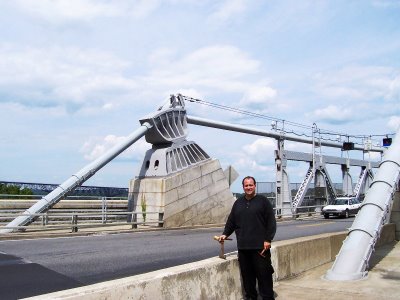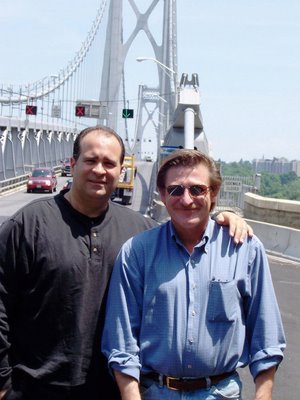BRIDGE MUSIC

For the development/proof of concept stage, Bertolozzi will place mics on the very surfaces he wishes to use [cables, handrails, signs, spindles, etc.] and record them individually. From this data he will then make a demo recording to present to the New York State Bridge Authority for final approval for the actual event. There are walkways on both sides of the Mid Hudson Bridge, so onlookers and paparazzi alike can watch the proceedings as they unfold. Please stay tuned for the exact date of this first phase. For more info go to www.JosephBertolozzi.com, go to the CALENDAR menu and click on LATEST NEWS.

There have been myriad responses from people when I’ve described Bridge Music to them for the first time, but they essentially boil down to two models: the first involves the listener bobbing his or her head with a smile in affirmation while their brows furrow and their eyes progressively fix in an expression of incomprehension. This is typically followed by the sentence “Say that again?” The second, usually delivered by people who sort of get it, is about 40 seconds of laughter. I am prepared for this if it happens when I’m on the phone, and I usually put the receiver down until they finish. There are the usual questions (How will you hear it? Will traffic be stopped?), then the consensus is that it’s a terrific idea, but you get the sense that when they’re wishing you luck, it’s at least as much so that you don’t get carted off to the rest home.
In the next chapter I’ll detail the project in greater depth, but for now it’s enough to know that in Bridge Music I want to create a live, public musical event specifically using the Mid-Hudson Bridge, a suspension bridge crossing the Hudson River in Poughkeepsie, NY as my instrument. Using the railings, spindles, fences, trusses, panels, cables, hangers (those cables which suspend the bridge’s deck), and in fact any part of the bridge except the roadway (which will be left open to traffic) to compose vibrant, site-specific music, expanding the boundaries of known music-making while integrally incorporating one of New York’s landmarks, using the river and mountains themselves as my theater.

Composer Joseph Bertolozzi & Mid Hudson Bridge Chief Engineer Bill Moreau
Proof of concept
And so I begin the final countdown to what engineers call “proof of concept.” In the music field it would be called the demo. I have to demonstrate to the officers of the New York State Bridge Authority that my claims of the bridge being perfectly suited for music are rooted in hard fact borne of quantified results, not only in the elusive dream world of a creative artist. I’ll do this by recording the surfaces of the bridge and then retiring to the studio with those samples to write a piece for 16 percussionists, much as if I were writing a piece for 16 violins, the difference being, unlike imagining violin music, it is understandably harder for NYSBA (and anyone else except me apparently) to imagine what the bridge might sound like. The live performances would sound very much like this demo since the actual sound heard on the shores would be transmitted to speakers via the same contact microphones used in the demo recording, and from there it is a small step to radio/web/pod/tele-casting the concerts as well.
On Friday June 16, 2006, in preparation for the actual recording date (sometime during the week of July 17, 2006, weather permitting), I took a tour of the inside of one of the bridge towers. These interior visits brought me to parts of the bridge I couldn’t view firsthand just by walking across it, and now I can dream about how, or even if I want to use those spaces for my composition.
Low bridge and long ladders
Chief Engineer Bill Moreau and Joe, one of the laborers, started me out underneath the deck, traveling at about 1 mph on a motorized metal scaffold called a ‘traveler,’ with tons of vehicles rumbling overhead. Speaking of overhead, if you ever have the unlikely chance to ride on one of these, remember to either crouch as you ride or duck every twenty feet because those floor beams sure don’t care that you’re coming up. I struck a few surfaces with my mallets just to get a sense of them, but reminded myself, as my fellow passengers looked on unimpressed, that these clanks would sound different through a contact mic.
Next was the trip up to the top of the tower to stand out in the open on a metal grate-catwalk more than 300 ft. over the river, a voyage I had been mentally preparing for awhile. I’m not especially afraid of heights, but this was clearly going to be a new experience for me. Not having the training or insurance to walk up outside on the main cable like most bridge workers would, I had to take the interior ladder, climbing 178 ft. straight up in a 3 ft. x 3 ft. chamber.
Now I consider myself a man of great stamina, once having played my solo percussion project The Bronze Collection several times over the course of a week for two four-hour stretches in direct sunlight at the US Tennis Open as part of their grounds entertainment. Also as an organist (my primary instrument) I’ve had to sit and produce music for 4-5 Masses in a row plus a wedding or two afterwards and still sound fresh. It’s one thing to sit and move your fingers all day in church or temple (Yom Kippur…yikes!) or play percussion for hours on end, but I never ordinarily or willingly pick up hand tools, and having to pull myself up furlong after furlong (it seemed like that anyway) was very taxing on my grip. I coped by mainly using my hands to grab the next rung, and using my legs to push me upwards rather than pulling myself up with my “organist arms”…’nuff said. My main focus was to keep from plummeting another 150 ft. down to the bottom.
That’s not true, for before I would drop all the way down, I surely would be greeted by one of the bulkhead-like floors that separate each vertical chamber. You’ll get some sense of it from the photo but you won’t really see how far down it goes. Also, don’t let the camera flash fool you…it’s dark in there, and that’s another thing you should know before playing a bridge: it’s not for you if you are acrophobic, claustrophobic, and whatever the word is for bridge-ophobic.
 Looking down inside the West Tower
Looking down inside the West Tower
After ascending about 150 ft, I got within 30 ft. of the top (I was told this by Bill who climbed up ahead of me. Remember this chamber has no windows; you go from the inside to the outside with no preparation). Being used to walking up on the outside of the cable, he forgot that there is an extremely narrow passage to go through that even he would have trouble getting through (see first picture). I was in no position to argue so we turned back, or rather, down. I hope to make another attempt because we went through another very narrow passage at the bottom of the tower, and Bill, a trim man considerate of my current girth, probably doesn’t realize how much fat compresses. Then again I wouldn’t want to get stuck up there.
Next it was down to the masonry of the piers, a descent of about 250 ft. ending up 35 feet above the water. There we found some very responsive surfaces. They were very broad and very thin, producing a nice ring or hum when struck with the side of my fist. The ladder-chamber floor openings were so narrow that I couldn’t carry any hammers or notebooks or backpacks or anything else to juggle with me. I was able to tuck a very small camera into a buttoned pocket, but that was it.
http://www.nysba.state.ny.us/bridgepages/MHB/MHBpage/mhb_page.htm
This takes you on a virtual walk across the Mid Hudson Bridge.
http://www.exploreny400.com/home.php
Text and all photos © 2006, Blue Wings Press.
All rights reserved. Used with Permission.

0 Comments:
Post a Comment
<< Home